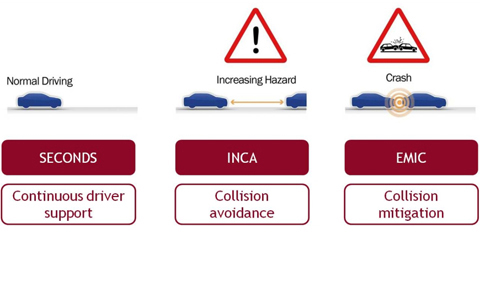objectives: accident avoidance and collision mitigation
The scientific objectives of interactIVe focused on the design, development, and evaluation of integrated ADAS applications. Five major scientific objectives have been defined. All of them serveed the purpose to cover more scenarios, to enhance system intelligence, and to avoid full collision:
- Extend the range of possible scenarios and the usability of ADAS:
The focus was on joint steering and braking actuations. Two specific areas were investigated: continuous driving support and emergency interventions. Collision avoidance have thus become more effective.
- Improve decision strategies for active safety and driver-vehicle-interaction:
Three areas were addressed:
- New technologies for the dynamic prediction of a safe trajectory ahead.
- Decision strategies leaving the final control to the driver in all cases.
- Advanced human machine interface (HMI) concepts integrated into the primary driving controls.
- Develop solutions for collision mitigation with market potential for lower automobile segments:
ADAS concepts for reducing accident severity have been further developed. Specific attention was given to vehicle architecture in the low-medium segment of passenger cars, and on cost effective sensors in combination with relevant accident scenarios.
- Create an innovative platform for enhancing the perception of the driving situation:
One main target was to integrate the environment sensing information as a part of the perception layer, including the inertial sensors, digital maps, and vehicle-to-vehicle as well as vehicle-to-infrastructure communication.
- Advance the application of standard methodologies for the evaluation of ADAS:
interactIVe continued the work of PReVENT and other European projects by using structured methods for the evaluation of safety functions. A modular evaluation framework was being defined to co-ordinate all testing.


by the European Commission





